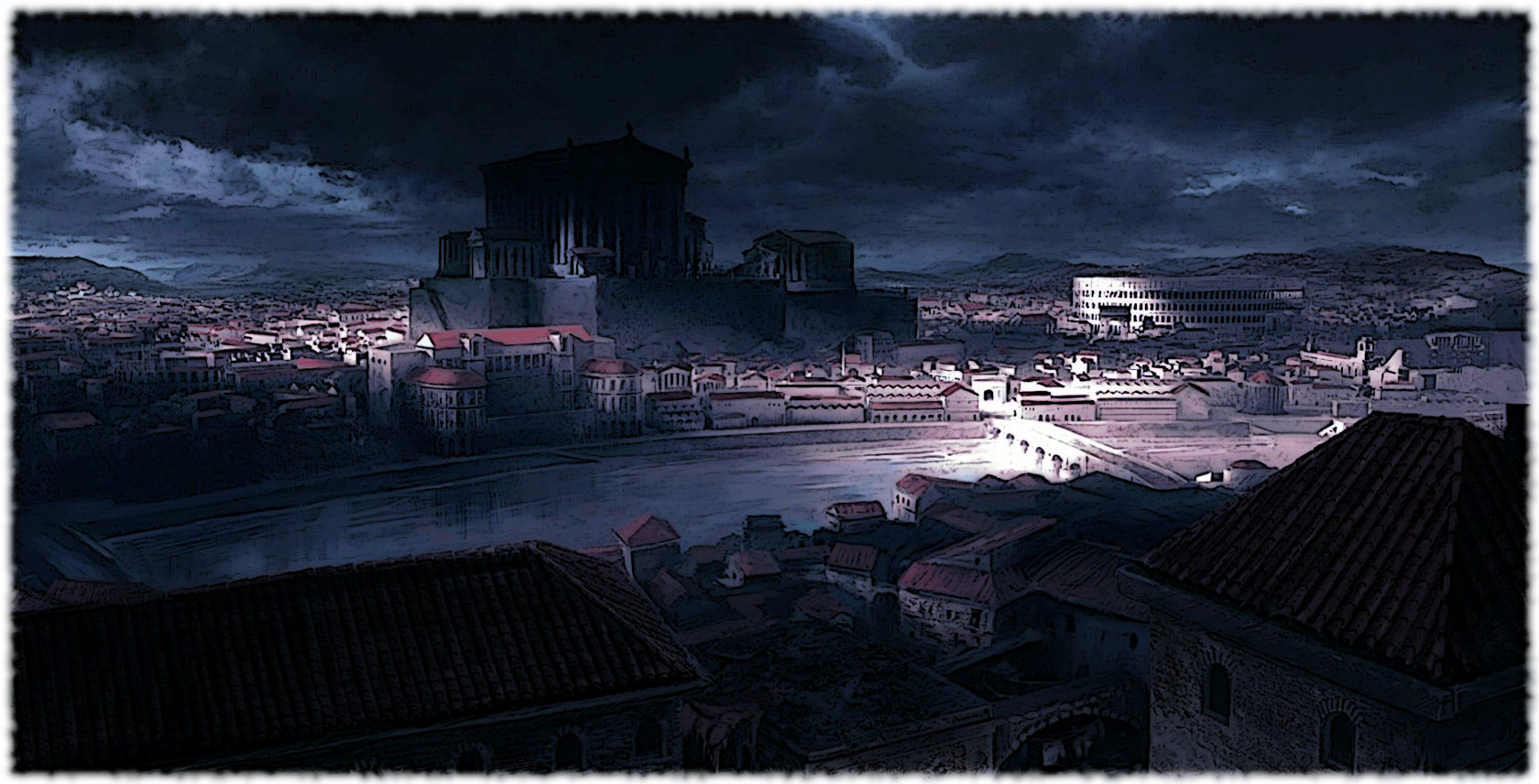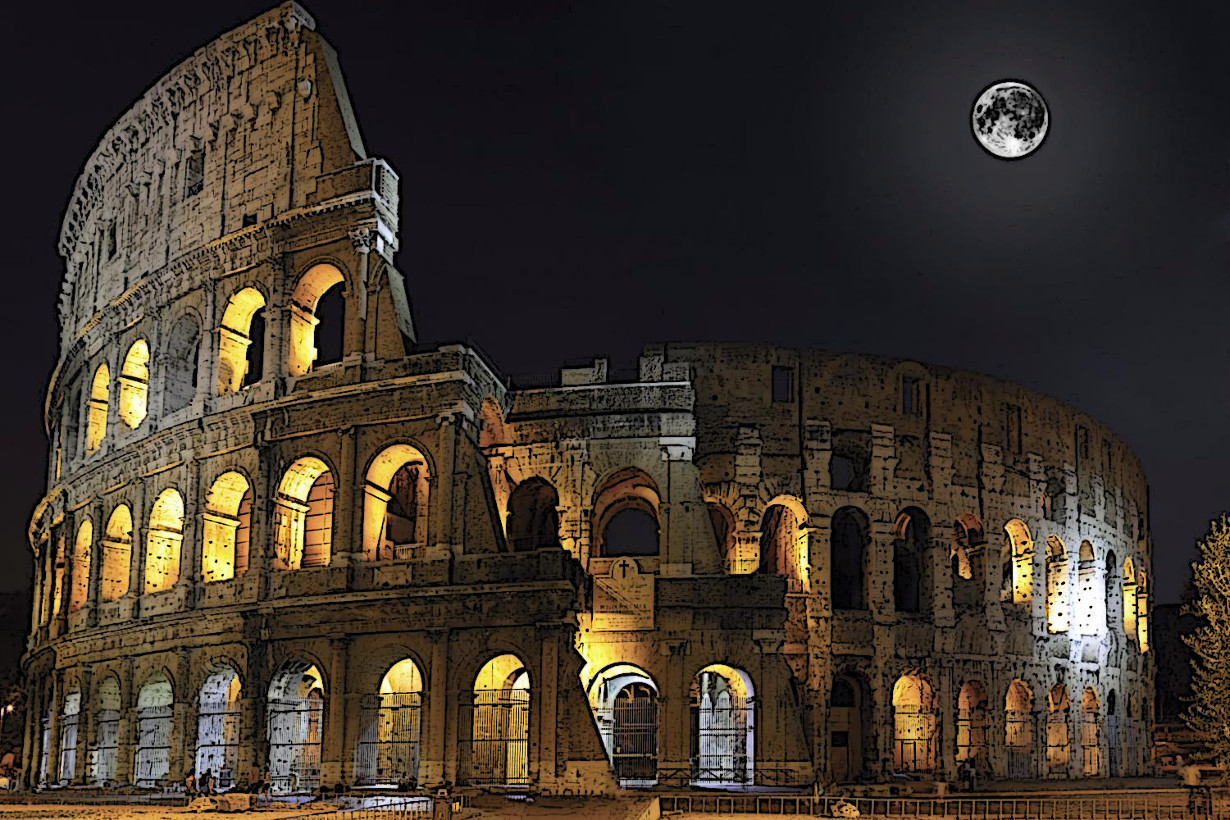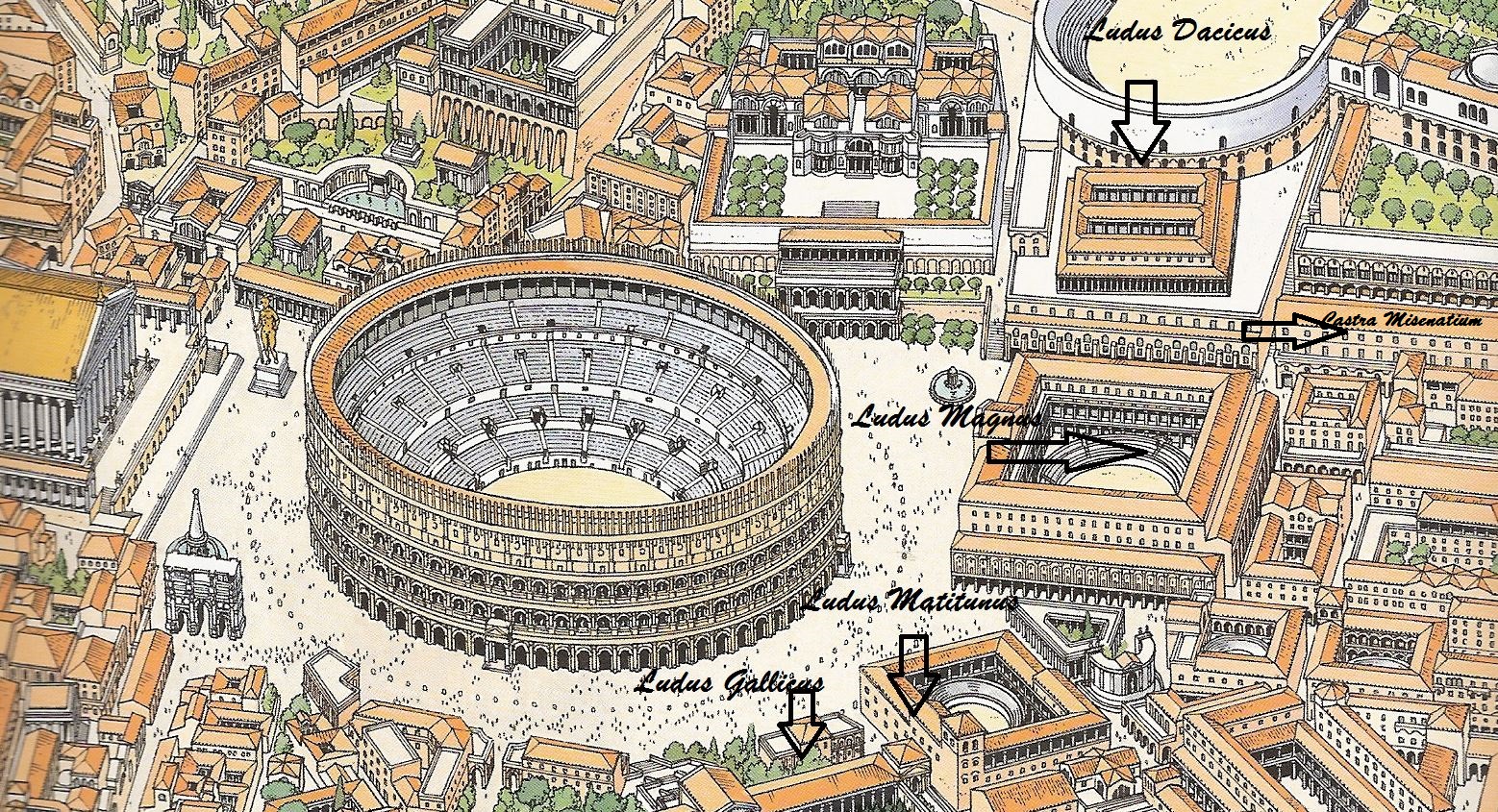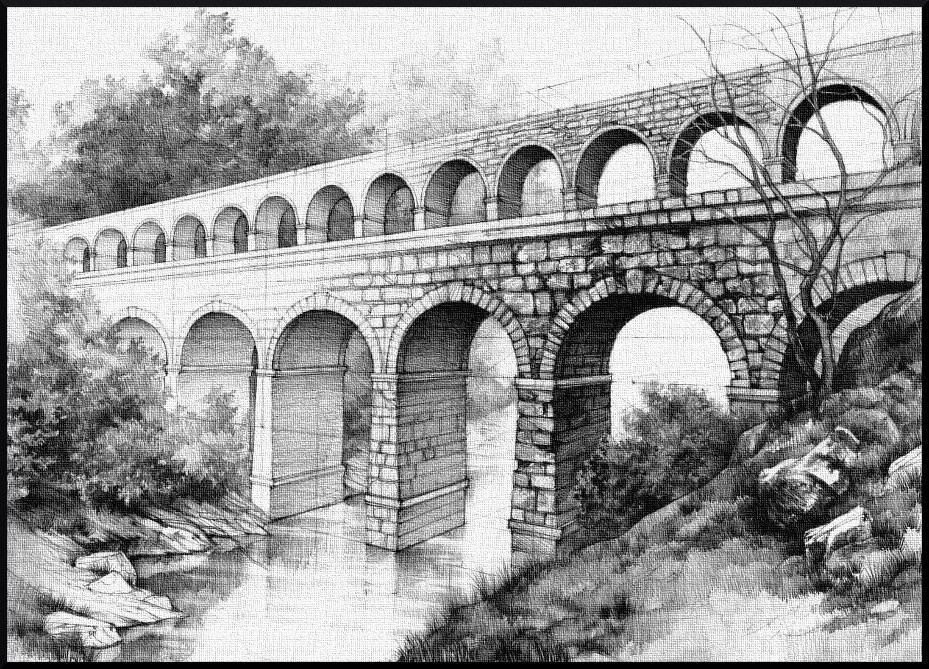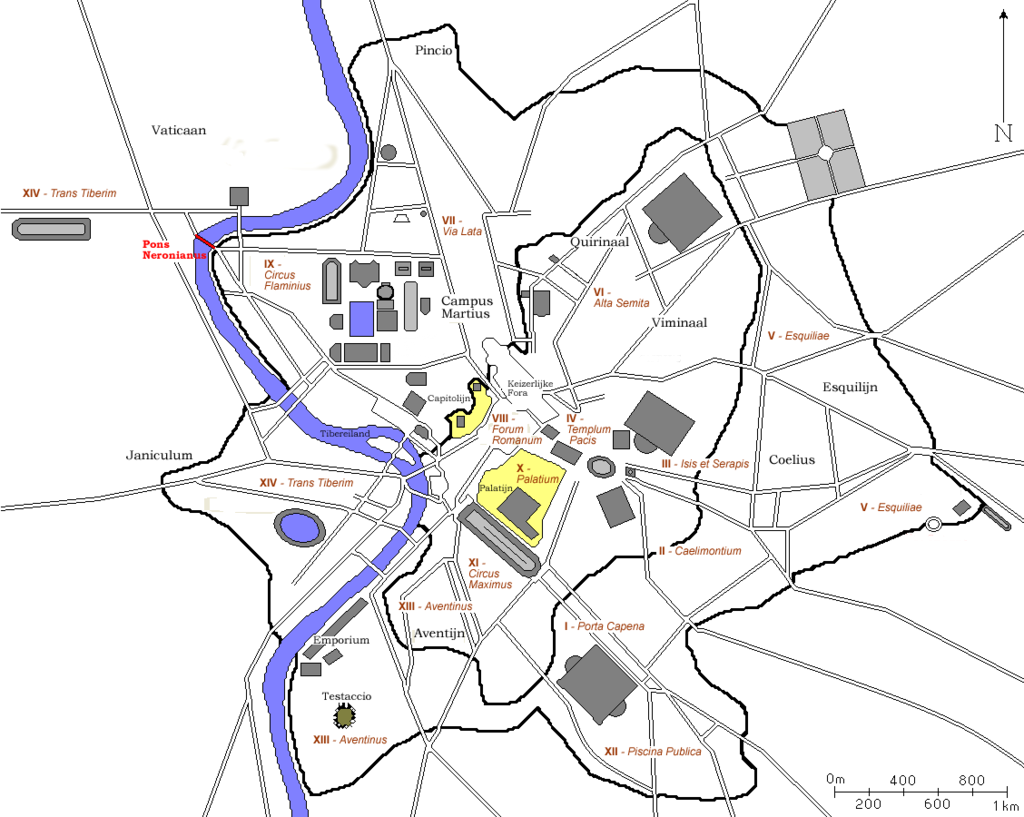Difference between revisions of "Roma"
(→The House Imperial) |
(→The House Imperial) |
||
| Line 88: | Line 88: | ||
:::~ Lucius Caesar -- Second grandson and heir to Augustus {Deceased in AD.2} | :::~ Lucius Caesar -- Second grandson and heir to Augustus {Deceased in AD.2} | ||
:::~ Julia the Younger -- was the elder granddaughter of the Emperor Augustus - 28yrs old | :::~ Julia the Younger -- was the elder granddaughter of the Emperor Augustus - 28yrs old | ||
| − | :::~ Agrippina the Elder -- | + | :::~ Agrippina the Elder -- The younger granddaughter of the Emperor Augustus and widow of Germanicus - 23yrs old |
:::~ Agrippa Postumus -- Youngest surviving male heir and grandson of the Emperor Augustus {Exiled} - 21yrs old | :::~ Agrippa Postumus -- Youngest surviving male heir and grandson of the Emperor Augustus {Exiled} - 21yrs old | ||
Revision as of 00:38, 1 February 2020
Contents
- 1 Quote
- 2 Appearance
- 3 Climate
- 4 Economy
- 5 Geography
- 6 History
- 7 Politics
- 8 Population
- 9 Citizens of Rome
- 10 Festivities
- 11 Fortifications
- 12 Inns
- 13 Law & Lawlessness
- 14 Monuments
- 15 Regiones de Roma
- 16 Objects
- 17 Private Residences
- 18 Taverns
- 19 Religion
- 19.1 Gods of Rome
- 19.2 Cults
- 19.3 Pagan Temples
- 20 Visitors
- 21 Whore Houses
- 22 Nocturna Animalia
- 23 Wraiths of Rome
- 24 Storytelling Imperial Rome
- 25 Websites
Quote
Appearance
Climate
Rome has a Mediterranean climate, with cool, humid winters and warm, dry summers.
Its average annual temperature is above (68 °F) during the day and (50 °F) at night. In the coldest month – January, the average temperature is (54 °F) during the day and (37 °F) at night. In the warmest months – July and August, the average temperature is (86 °F) during the day and (64 °F) at night.
December, January and February are the coldest months, with a daily mean temperature of (46 °F). Temperatures during these months generally vary between (50 and 59 °F) during the day and between (37 and 41 °F) at night, with colder or warmer spells occurring frequently. Snowfall is rare but not unheard of, with light snow or flurries occurring almost every winter, generally without accumulation, and major snowfalls approximately once every 5 years.
The average relative humidity is 75%, varying from 72% in July to 77% in November. Sea temperatures vary from a low of (55 °F) in February and March to a high of (75 °F) in August
Economy
[[]]
Geography
Rome is in the Lazio region of central Italy on the Tiber (Italian: Tevere) river. The original settlement developed on hills that faced onto a ford beside the Tiber Island, the only natural ford of the river in this area. The Rome of the Kings was built on seven hills: the Aventine Hill, the Caelian Hill, the Capitoline Hill, the Esquiline Hill, the Palatine Hill, the Quirinal Hill, and the Viminal Hill. Modern Rome is also crossed by another river, the Aniene, which flows into the Tiber north of the historic centre.
Although the city centre is about 24 kilometres (15 mi) inland from the Tyrrhenian Sea, the city territory extends to the shore, where the south-western district of Ostia is located.
Throughout the history of Rome, the urban limits of the city were considered to be the area within the city’s walls. Originally, these consisted of the Servian Wall, which was built twelve years after the Gaulish sack of the city in 390 BC. This contained most of the Esquiline and Caelian hills, as well as the whole of the other five. Rome outgrew the Servian Wall, but no more walls were constructed until almost 700 years later, when, in 270 AD, Emperor Aurelian began building the Aurelian Walls. These were almost 19 kilometres (12 mi) long, and were still the walls the troops of the Kingdom of Italy had to breach to enter the city in 1870.
History
Timeline
The Principate
The Restoration of the Republic
By the end of the Republic, the city of Rome had achieved a grandeur befitting the capital of an empire dominating the whole of the Mediterranean. It was, at the time, the largest city in the world. Estimates of its peak population range from 450,000 to over 3.5 million people with estimates of 1 to 2 million being most popular with historians. This grandeur increased under Augustus, who completed Caesar's projects and added many of his own, such as the Forum of Augustus and the Ara Pacis. He is said to have remarked that he found Rome a city of brick and left it a city of marble (Urbem latericium invenit, marmoream reliquit). Augustus's successors sought to emulate his success in part by adding their own contributions to the city.
Current Events
Politics
History
Population
- 762 A.U.C. - Annual Census: 2,487,669
Citizens of Rome
The House Imperial
- ~ Gaius Octavius -- Princeps Civitatis ("First Citizen of the State") - 72yrs old
- ~ Livia Drusilla -- Title (Augusta) - 67yrs old
- ~ Tiberius Julius Caesar -- Son of Livia Drusilla and Tiberius Claudius Nero, he is Augustus son by adoption and heir to the Empire. - 51yrs old
- ~ Germanicus Julius Caesar -- Pollux - son of Nero Claudius Drusus and Antonia Minor and adopted by Tiberius - 24yrs old - {deceased - AD.9}
- ~ Drusus Julius Caesar -- Castor - the son of Emperor Tiberius and Vipsania Agrippina and heir to Tiberius - 23yrs old
- ~ Livilla -- Only daughter of Nero Claudius Drusus and Antonia Minor, sister of Claudius and Germanicus, and wife of Drusus Caesar. - 22yrs old
- ~ Julia the Elder -- Daughter of Augustus {Exiled} - 48yrs old
- ~ Marcus Vipsanius Agrippa -- A famous general, husband of Julia the Elder, and a close friend and heir of Augustus {Deceased}
- ~ Gaius Caesar -- Eldest grandson and heir to Augustus {Deceased in AD.4}
- ~ Lucius Caesar -- Second grandson and heir to Augustus {Deceased in AD.2}
- ~ Julia the Younger -- was the elder granddaughter of the Emperor Augustus - 28yrs old
- ~ Agrippina the Elder -- The younger granddaughter of the Emperor Augustus and widow of Germanicus - 23yrs old
- ~ Agrippa Postumus -- Youngest surviving male heir and grandson of the Emperor Augustus {Exiled} - 21yrs old
- ~ Tiberius Julius Caesar -- Son of Livia Drusilla and Tiberius Claudius Nero, he is Augustus son by adoption and heir to the Empire. - 51yrs old
- ~ Antonius Musa -- Imperial Physician
Roman Senators
- ~ Gaius Asinius Gallus Saloninus -- the son of Gaius Asinius Pollio, consul in 40 BC, and Quinctia. He is best known as the second husband of Vipsania, eldest daughter of Marcus Vipsanius Agrippa and first wife of Tiberius, who will ultimately imprisoned him.
- ~ Vipsania Agrippina -- Wife of Senator Saloninus and mother of Drusus Julius Caesar
- ~ Avitus -- '
- ~ Iunius -- Grandson of Marcus Junius Brutus
- ~ [[]] -- '
- ~ [[]] -- '
- ~ [[]] -- '
- ~ [[]] -- '
- ~ [[]] -- '
- ~ [[]] -- '
- ~ [[]] -- '
- ~ [[]] -- '
Patricians (aristocrats)
- ~ [[]] -- '
- ~ [[]] -- '
- ~ [[]] -- '
- ~ [[]] -- '
- ~ [[]] -- '
- ~ [[]] -- '
- ~ Diadumenianus -- Owner of the Amphitheatrum Castrense
Clergy
- ~ Quintillus -- Priest of Mars
- ~ [[]] -- '
- ~ [[]] -- '
- ~ [[]] -- '
- ~ [[]] -- '
- ~ [[]] -- '
- ~ [[]] -- '
- ~ [[]] -- '
- ~ [[]] -- '
- ~ [[]] -- '
- ~ [[]] -- '
- ~ Laurentina -- High Priestess of Pluto
- ~ Tertius -- Priest of Pluto
Priesthood of Morpheus
Equites Equestrians
- ~ Antonius Lucius + Junia -- Political Dud *
- ~ [[]] -- '
- ~ [[]] -- '
- ~ [[]] -- '
- ~ Sejanus -- Captain of the Praetorian Guard
Merchants
- ~ Porcius + Hortensia -- Merchant of Flesh *
- ~ Claudius Sextilius Marcellus -- Deceased Merchant and Former husband to Caelina
- ~ Caelina Marcellus -- Recent Widow and Friend of Cercyon
- ~ Florianus -- Chariot and Wagoneer
- ~ Appius Cassianus -- Truffle Merchant
Guilds
- Tertius -- Guildmaster of Bakers
Craftsmen
- ~ Salvius -- Architect
- ~ [[]] -- '
- ~ [[]] -- '
- ~ [[]] -- '
- ~ [[]] -- '
Plebs (commoners)
- ~ Sabinus -- Legit Nuntium (Public Speaker - News Anouncer) *
- ~ Lucilia -- Upcoming Whore *
- ~ Lucius -- Father of Faustina
- ~ Faustina -- Daughter of Lucius
- ~ Martinus Gnaeus -- Vigiles Urbani (Watchman of the City)
Slaves
- ~ Valerius the Young -- Palace Herald
- ~ [[]] -- '
- ~ [[]] -- '
- ~ [[]] -- '
- ~ [[]] -- '
Gladiators
- ~ Ercanbald -- Master Gladiator
- ~ [[]] -- '
- ~ [[]] -- '
- ~ [[]] -- '
- ~ [[]] -- '
Criminals
- ~ Avilius -- Albino Thief *
- ~ [[]] -- '
- ~ [[]] -- '
- ~ Naevius -- Roman Fagin
- ~ Tatiana -- Little Girl
Nightwalkers
- ~ [[]] -- '
- ~ [[]] -- '
- ~ [[]] -- '
- ~ [[]] -- '
Expatriates
- ~ Publius Ovidius Naso -- AKA: Ovid (Roman Poet)
- ~ Pax Romana Prototype -- '
- ~ NPC Prototype -- '
Festivities
Fortifications
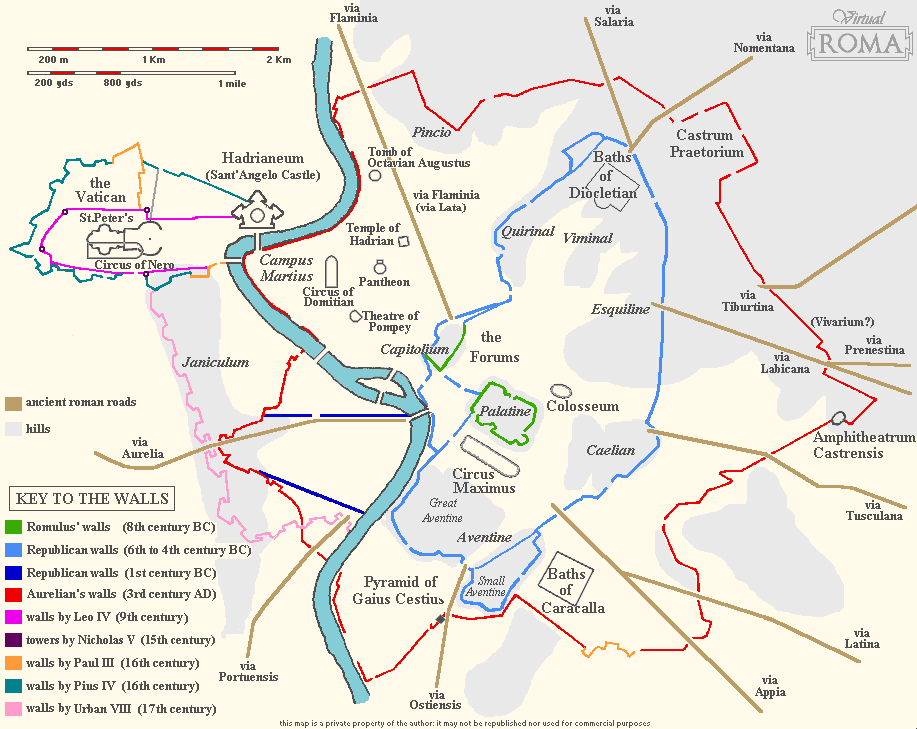
Defensive walls are a feature of ancient Roman architecture. The Romans generally fortified cities, rather than fortresses, but there are some fortified camps, such as the Saxon Shore forts like Porchester Castle in England. City walls were already significant in Etruscan architecture, and in the struggle for control of Italy under the early Republic many more were built, using different techniques. These included tightly-fitting massive irregular polygonal blocks, shaped to fit exactly in a way reminiscent of later Inca work. The Romans called a simple rampart wall an agger; at this date great height was not necessary.
Servian Wall
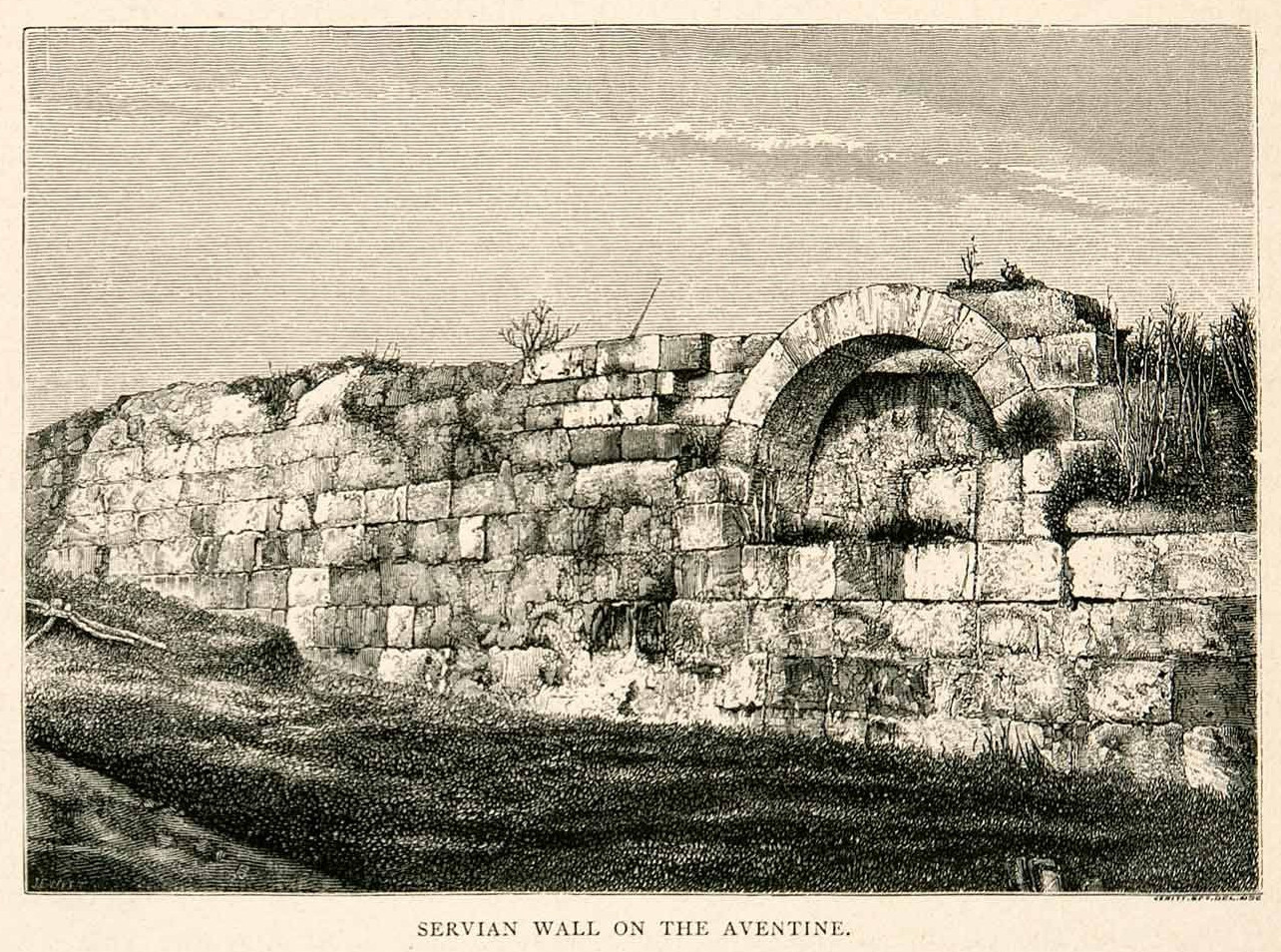
The Servian Wall (outlined in blue) was an ancient Roman defensive barrier constructed around the city of Rome in the early 4th century BC. The wall was up to 10 metres (32.8 ft) in height in places, 3.6 metres (12 ft) wide at its base, 11 km (7 mi) long,[1] and is believed to have had 16 main gates, though many of these are mentioned only from writings, with no other known remains. By the 3rd century AD it was superseded by the construction of the larger Aurelian Walls.
History
It is presumed that the wall is named after the sixth Roman King, Servius Tullius. Although its outline may go back to the 6th century BC, the currently extant wall was, it is estimated, built during the early Roman Republic, possibly as a way to prevent a repeat of the sack of Rome after the Battle of the Allia by the Gauls of Brennus. Due to the ease with which the Gauls entered the city, it is conjectured[by whom?] that at some time previous to this, Rome had been forced by its Etruscan rulers to dismantle any significant prior defenses.
Construction
The wall was built from large blocks of tuff (a volcanic rock made from ash and rock fragments ejected during an eruption) quarried from the Grotta Oscura quarry near Rome's early rival Veii. In addition to the blocks, some sections of the structure incorporated a deep fossa, or ditch in front of it, as a means to effectively heighten the wall during attack from invaders.
Along part of its topographically weaker northern perimeter was an agger, a defensive ramp of earth heaped up to the wall along the inside. This thickened the wall, and also gave defenders a base to stand while repelling any attack. The wall was also outfitted with defensive war engines, including catapults.
Usage
The Servian Wall was formidable enough to repel Hannibal during the Second Punic War. Hannibal famously invaded Italy across the Alps with elephants, and had crushed several Roman armies in the early stages of the war. However, the wall was never put to the test as Hannibal only once, in 211 BC, brought his Carthaginian army to Rome as part of a feint to draw the Roman army from Capua. When it was clear that this had failed, he turned away, without approaching closer than 3 miles (5 km) to Rome, as a Roman army sallied out of the Servian walls and pitched a camp next to Hannibal's. During the Roman civil wars, the Servian walls were repeatedly overrun.
The wall was still maintained through the end of the Republic and in the early Empire. By this time, Rome had already begun to grow outside the original Servian Wall. The organization of Rome into regions under Augustus placed regions II, III, IV, VI, VIII, X, and XI within the Servian Wall, with the other sections outside of it.[citation needed]
The wall became unnecessary as Rome became well protected by the ever-expanding military strength of the Republic and of the later Empire. As the city continued to grow and prosper, it was essentially unwalled for the first three centuries of the Empire.
Gates
List of gates (porte), from the northernmost and clockwise:
• Porta Flaminia – here begins via Flaminia
• Porta Pinciana
• Porta Salaria – here begins via Salaria
• Porta Pia – here begins the new via Nomentana
• Porta Nomentana – here began the old via Nomentana
• Porta Praetoriana – entrance to Castra Praetoria, the camp of the Praetorian Guard
• Porta Tiburtina – here begins via Tiburtina
• Porta Praenestina) – here three aqueducts meet, and via Praenestina begins
• Porta Asinaria – here begins the old via Tuscolana
• Porta Metronia
• Porta Latina – here begins via Latina
• Porta Appia – here begins the Appian Way
• Porta Ardeatina
• Porta Ostiense – next to the Pyramid of Cestius, leading to Basilica di San Paolo fuori le Mura, here via Ostiense begins
Inns
Law & Lawlessness
- Vigilum: City Police
Monuments
See: List of ancient monuments in Rome -- Wikipedia
Amphitheaters
- Amphitheatrum Castrense -- An ancient Roman amphitheater situated upon the Esquiline Hill. (Location: Esquiline Hill)
- Amphitheater of Statilius Taurus -- An ancient amphitheater.
Ludus of Rome
Aqueducts
- Anio Novus
- Anio Vetus
- Aqua Alexandriana
- Aqua Alsietina
- Aqua Appia
- Aqua Augusta (Rome)|Aqua Augusta
- Aqua Claudia
- Aqua Julia
- Aqua Marcia
- Aqua Martia
- Aqua Tepula
- Aqua Traiana
- Aqua Virgo
Arches (Triumphal)
- Arcus Argentariorum
- Arcus Novus
- Arch of Augustus
- Arch of Dolabella and Silanus
- Arch of Drusus
- Arch of Janus
- Arch of Lentulus and Crispinus
- Arch of Octavius
- Arch of Pietas
- Arch of Titus (Circus Maximus)
- Arch of Titus (Roman Forum)
Baths
Bridges
[[]]
- Pons Aemilius
- Pons Cestius
- Pons Fabricius
- Pons Milvius
- Pons Probi
- Pons Sublicius
Catacombs
Rome has a extensive number of ancient catacombs, or underground burial places beneath or near the city, of which there are at least forty. Though most famous for Christian burials, they include pagan and Jewish burials, either in separate catacombs or mixed together. The first large-scale catacombs were excavated from the 2nd century onwards, mainly as a response to overcrowding and shortage of land. Originally they were carved through tuff, a soft volcanic rock, outside the boundaries of the city, because Roman law forbade burial places within city limits.
Those Who Came Before
The Etruscans, like many other European people, used to bury their dead in underground chambers. The original Roman custom was cremation, after which the burnt remains were kept in a pot, ash-chest or urn, often in a columbarium. From about the 2nd century AD, inhumation (burial of unburnt remains) became more fashionable, in graves or sarcophagi, often elaborately carved, for those who could afford them. Christians also preferred burial to cremation because of their belief in bodily resurrection at the Second Coming.
Jews and Christians
Since most Christians and Jews at that time belonged to the lower classes or were slaves, they usually lacked the resources to buy land for burial purposes. Instead, networks of tunnels were dug in the deep layers of tuff which occurred naturally on the outskirts of Rome. At first, these tunnels were probably not used for regular worship, but simply for burial and, extending pre-existing Roman customs, for memorial services and celebrations of the anniversaries of Christian martyrs. There are sixty known subterranean burial chambers in Rome. They were built outside the walls along main Roman roads, like the Via Appia, the Via Ostiense, the Via Labicana, the Via Tiburtina, and the Via Nomentana. Names of the catacombs – like St Calixtus and St Sebastian, which is alongside Via Appia – refer to martyrs that may have been buried there. About 80% of the excavations used for Christian burials date to after the time of the persecutions.
Construction
Roman catacombs are made up of underground passages (ambulacra), out of whose walls graves (loculi) were dug. These loculi, generally laid out vertically (pilae), could contain one or more bodies. A loculus large enough to contain two bodies was referred to as a bisomus. Another type of burial, typical of Roman catacombs, was the arcosolium, consisting of a curved niche, enclosed under a carved horizontal marble slab. Cubicula (burial rooms containing loculi all for one family) and cryptae (chapels decorated with frescoes) are also commonly found in catacomb passages. When space began to run out, other graves were also dug in the floor of the corridors - these graves are called formae.
Excavators (fossors), built vast systems of galleries and passages on top of each other. They lie 7–19 metres (23–62 ft) below the surface in an area of more than 2.4 square kilometres (590 acres). Narrow steps that descend as many as four stories join the levels. Passages are about 2.5 by 1 metre (8.2 ft × 3.3 ft). Burial niches (loculi) were carved into walls. They are 40–60 centimetres (16–24 in) high and 120–150 centimetres (47–59 in) long. Bodies were placed in chambers in stone sarcophagi in their clothes and bound in linen. Then the chamber was sealed with a slab bearing the name, age and the day of death. The fresco decorations provide the main surviving evidence for Early Christian art, and initially show typically Roman styles used for decorating homes - with secular iconography adapted to a religious function. The catacomb of Saint Agnes is a small church. Some families were able to construct cubicula which would house various loculi and the architectural elements of the space would offer a support for decoration. Another excellent place for artistic programs were the arcosolia.
The Catacombs of Rome
The Roman catacombs, of which there are forty in the suburbs, were built along the consular roads out of Rome, such as the Appian way, the via Ostiense, the via Labicana, the via Tiburtina, and the via Nomentana.
- Jewish Catacombs -- There are six known Jewish catacombs in Rome, two of which are open to the public: Vigna Randanini and Villa Torlonia.
Cemeteries
- Columbarium of Pomponius Hylas -- is a 1st-century AD Roman columbarium, situated near the Porta Latina on the Via Appia. Columbarium
- Esquiline Necropolis -- The Esquiline Necropolis was a prehistoric necropolis on the Esquiline in Rome, in use until the end of the 1st century AD.
- Vatican Necropolis -- The Vatican Necropolis lies on the upper slopes of Vatican Hill.
Circuses
Columns
Fountains
Gardens
Libraries
Mausolea
Porticoes
- ~ Porticus Octaviae -- The colonnaded walks of the portico enclose the temples of Jupiter Stator and Juno Regina, as well as a library. {Located close to the the Theatre of Marcellus upon the Capitoline Hill}
Statues
Theaters
- ~ Theatre of Marcellus -- is an ancient open-air theatre in Rome, built in the closing years of the Roman Republic. {Capitoline Hill}
Tombs
Regiones de Roma
- I: Regio I Porta Capena
- Regio I took its name from the Porta Capena ("Gate to Capua"), a gate through the Servian Walls which the Appian Way takes to get into the city. Beginning from this to the south of the Caelian Hill, it runs to the future track of the Aurelian Walls.
- II: Regio II Caelimontium
- Regio II encompassed the Caelian Hill.
- III: Regio III Isis et Serapis
- Regio III took its name from the sanctuary of Isis, in the area of the modern Labicana street, containing the valley which was to be the future site of the Colosseum, and parts of the Oppian and Esquiline hills.
- IV: Regio IV Templum Pacis
- Regio IV took its name from the Temple of Peace built in the region by Vespasian. It includes the valley between the Esquiline and the Viminal hills, the popular area of the Subura, and the Velian Hill (the hill between the Palatine and the Oppian Hill, removed in the early 20th century to make way for the via dei Fori Imperiali, the street passing between the Forum Romanum and the Forum of Augustus).
- V: Regio V Esquiliae
- The name of Regio V derives from the Esquiline hill. It contains parts of the Oppian and Cispian (two minor hills close to the city center) and of the Esquiline, plus the plain just outside the Servian walls.
- VI: Regio VI Alta Semita
- The name of Regio VI derives from the street (Alta Semita, "High Path") passing over the Quirinal Hill. It was a large regio that encompassed also the Viminal Hill, the lower slopes of the Pincian, and the valleys between these. Its major landmarks included the Baths of Diocletian, the Baths of Constantine, and the Gardens of Sallust; gardens (horti) covered much of its northern part. Temples to Quirinus, Salus, and Flora were also located in Regio VI, and the Castra Praetoria. The Aurelian Wall marked most of its eastern and northern edge, with the Argiletum and Vicus Patricius on the south and southeast.[2]
- VII: Regio VII Via Lata
- The name of Regio VII was derived from the via Flaminia which runs between the Servian walls and the future Aurelian Walls. This was a wide urban street (Via Lata, "Broadway"), corresponding to the modern via del Corso. The regio contained part of the Campus Martius on the east of the street plus the Collis Hortulorum (Hill of the Hortuli), the Pincian Hill (modern Pincio).
- VIII: Regio VIII Forum Romanum
- The central region contains the Capitoline Hill, the valley between the Palatine and the Capitoline hills (where the Forum Romanum is located), and the area between Velian Hill and the Palatine up to the Arch of Titus and the Temple of Venus and Roma.
- IX: Regio IX Circus Flaminius
- The name derives from the racecourse located in the southern end of the Campus Martius, close to Tiber Island. The region contains part of the Campus Martius, on the west side of via Lata.
- X: Regio X Palatium
- The Palatine Hill gave its name to Regio X.
- XI: Regio XI Circus Maximus
- Regio XI took its name from the Circus Maximus, located in the valley between the Palatine and the Aventine. It contained the Circus Maximus, the Velabrum (the valley between the Palatine and Capitoline), as well as the areas next to the Forum Boarium and the Forum Holitorium.
- XII: Regio XII Piscina Publica
- Regio XII took its name from the Piscina Publica, a monument that disappeared during the Empire. It had the high ground where the church of San Saba is at present, plus its ramifications towards the Appian Way, where Caracalla's baths were.
- In the 180s, a bank and exchange for Christians operated in the area.[3]
- XIII: Regio XIII Aventinus
- Regio XIII contained the Aventine Hill and the plain in front of it, along the Tiber. Here was the Emporium, the first port on the river.
- XIV: Regio XIV Transtiberim
- Regio XIV (the region "across the Tiber") contained Tiber Island and all the parts of Rome west beyond the Tiber. This is modern Trastevere.
https://en.wikipedia.org/wiki/14_regions_of_Augustan_Rome
Objects
Private Residences
Taverns
Religion
Gods of Rome
- ~ APHRODITE -- Goddess of Beauty & Love
- ~ ARES -- God of War
- ~ HEPHAESTUS -- God of Craft & Industry
- ~ HERMES -- God of Boundaries and Travel
Demigods
Divine Mortals
- ~ MEDITRINA -- Roman Goddess of Health, Longevity and Wine.
- ~ Gaius Julius -- Divine King
Cults
Pagan Temples
Aventine Hill
- Temple of Bona Dea
- Temple of Ceres
- Temple of Diana Aventina
- Temple of Juno Regina
- Temple of Luna
- Temple of Minerva
- Temple of Morpheus
Caelian Hill
- Temple of Claudius
Capitoline Hill
- Temple of Fides
- Temple of Jupiter Custos
- Temple of Jupiter Feretrius
- Temple of Jupiter Optimus Maximus
- Temple of Jupiter Tonans
- Temple of Juno Moneta
- Temple of Ops
- Temple of Veiovis
- Temple of Fortuna Redux
Campus Martius
- Pantheon
- Temple of Apollo Sosianus
- Temple of Bellona
- Temple of Castor and Pollux
- Temple of Cercyon -- Still in Construction, but Accepting Projects
- Temple of Diana (Rome)
- Temple of the Dii Inferi
- Temple of Feronia
- Temple of Fortuna Equestris
- Temple of Hadrian
- Temple of Hercules Custos
- Temple of Hercules Musarum
- Temple of Isis and Serapis
- Temple of Juno Regina
- Temple of Jupiter Stator
- Temple of Juturna
- Temple of the Lares
- Temple of Matidia
- Temple of the Sun
- Temple of Mars
- Temple of Minerva Chalcidica
- Temple of Neptunus
- Temple of Fortuna Huiusce Diei
- Temple of the Nymphs
- Temple of Vulcanus
Esquiline Hill
- Temple of Juno Lucina
- Temple of Minerva Medica (no longer extant)
- Nymphaeum called the 'Temple of Minerva Medica'
Forum Boarium
- Temple of Hercules Pompeianus
- Temple of Hercules Victor
- Temple of Fortuna
- Temple of Mater Matuta
- Temple of Portunus
- Temple of Pudicitia Patricia
Forum Holitorium
- Temple of Janus
- Temple of Juno Sospita
- Temple of Piety
- Temple of Spes
- Temple of Victoria
Forum Romanum
Imperial fora
- Temple of Mars Ultor
- Temple of Minerva
- Temple of Peace
- Temple of Venus Genetrix
Palatine Hill
- Elagabalium
- Temple of Apollo Palatinus
- Temple of Cybele
- Temple of Juno Sospita
- Temple of Victory
- Temple of Fortuna Respiciens
Quirinal Hill
- Temple of the Flavia gens
- Temple of Quirinus
- Temple of Serapis
Tiber Island
- Temple of Asclepius
- Temple of Faunus
Werewolf Septs
While there are many ancient and abandoned temples in Rome, not all are abandoned. Of the Septs of the Garou, until recently there were none. Now there are two, the Sept of the Scroll Bearers awakened by the Warders of Man and the Sept of the Capitoline Wolf awakened by the tribe of Shadow Lords.
Nearby Septs
Visitors
Whore Houses
Nocturna Animalia
Et Atrium Romanus (Court of Rome)
- Camilla -- The Second Prince of Rome during the transition from the Roman Republic to the Roman Empire — a period of time that includes the Punic Wars that destroyed Carthage.
Romanus Senatus (Roman Senators)
- Gracis Nostinus -- Ventrue Senator {Senior}
- Hadrianus -- Lasombra Senator
Nobilibus familiis Romanorum (High Clans)
- Brujah of Rome
- Cappadocians of the Eternal City
- The Lasombra of Medieval Rome
- Roman Toreador: A Tale of Two Families
- Ventrue: The Royal Linages of Rome
- Marius Maior -- Roman member of the line of Camilla.
Inferiore gens ab Roma (Low Clans)
Memoria pro Mortuis (Remembrances for the Dead)
- Collat -- First Prince of Rome, who officially abdicated in favor of his youngest childe Titus Venturus Camillus otherwise known as Camilla. Supposedly, he departed Rome in the last decades before the First Punic War.
Incognitos (Strangers and Aliens)
- Cassius -- Lord of the Catacombs {Rumored}
- Fabrizio Ulfila -- Ashen priest of Rome.
- Sybil -- Queen of Darkness
- The Sculptor -- Priest of Persephone
- Thaddeus -- The Penitent Pagan
- Trajan -- Exploratorem dominum
Wraiths of Rome
Storytelling Imperial Rome
Mood of Imperial Rome: Ambition / Secrecy / Spectacle
Theme:
The Roman Cainite Carnival: At Caesar Constantius' pleasure or in times of civil war, the prince can call for the Roman Carnival. Essentially, a period of Elysium, it serves as a time during which vendettas and feuds can lapse after a flair up. It is also called if some distinguished visitor arrives in the Eternal city. It bears more than a passing semblance to the Elysium of the Roman era, save that it lasts for a period of nights or weeks and only covers certain specified sites. Constantius can revoke the Roman carnival at will, but has rarely done so. It is one of the city's most stable and venerated traditions and has contributed to the survival of the nocturnal society of Roman Cainites.
Stories of the Eternal City
- :Tetrahedron -- A story of Revenge
Websites
